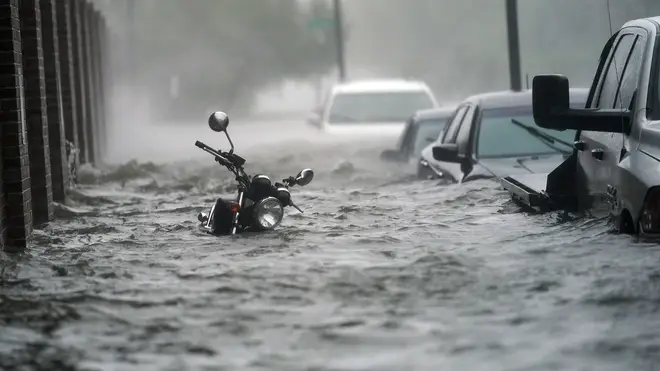
Ian Payne 4am - 7am
17 September 2020, 05:54

One person was killed in Orange Beach, Alabama, while another person is missing.
Hurricane Sally lumbered ashore near the Florida-Alabama line on Wednesday, killing at least one person, swamping homes and forcing the rescue of hundreds as it pushed inland.
The death happened in Orange Beach, Alabama, according to mayor Tony Kennon, who also told The Associated Press that one person was missing.
Moving at just 3 mph, the storm made landfall at 4.45am close to Gulf Shores, Alabama.
Sally cast boats onto land or sank them at the dock, flattened palm trees, peeled away roofs, blew down signs and knocked out power to more than 540,000 homes and businesses.
A replica of Christopher Columbus’s ship the Nina that had been docked at the Pensacola waterfront was missing, police said.
By the afternoon, authorities in Escambia County, Florida said at least 377 people had been rescued from flooded areas.
Authorities in Pensacola, Florida said 200 National Guard members would arrive on Thursday to help. Curfews were announced in Escambia County and in some coastal Alabama towns.
Sally turned some Pensacola streets into white-capped rivers early on Wednesday. Sodden debris and flooded cars were left behind as the water receded.
By early afternoon, Sally had weakened into a tropical storm. It was downgraded to a depression late Wednesday night with 35 mph sustained winds.
Tropical Storm Sally will continue to produce life threatening rainfall and flash flooding across the southeast. Another 4-6+" of rain is expected to fall from eastern AL through NC, spreading ) flash flooding northeast through Friday. Remember to #TurnAroundDontDrown . pic.twitter.com/L1CQtXcmq0
— NWS Weather Prediction Center (@NWSWPC) September 16, 2020
The National Weather Service said the system was still forecast to dump 4 to 8 inches of rain in southeast Alabama and central Georgia by Thursday night.
At least eight waterways in south Alabama and the Florida Panhandle were expected to hit their major flood levels by Thursday.
Some of the crests could break records, submerge bridges and flood some homes, the National Weather Service warned.
Escambia officials urged residents to rely on text messages for contacting family and friends to keep cellphone service open for 911 calls.
Sally was the second hurricane to hit the Gulf Coast in less than three weeks and the latest to blow in during one of the busiest hurricane seasons ever.
At the start of the week, Sally was one of a record-tying five storms churning simultaneously in the Atlantic basin.
Like the wildfires raging on the West Coast, the onslaught of hurricanes has focused attention on climate change, which scientists say is causing slower, rainier, more powerful and more destructive storms.
An emergency crew rescued two people on Dauphin Island, Alabama, after the hurricane ripped the roof off their home and the rest of the house began to crumble. Mayor Jeff Collier said no one was injured.

In Orange Beach, Alabama, the wind blew out the walls in one corner of a condominium building, exposing at least five floors.
At least 50 people were rescued from flooded homes and taken to shelters.
“We got a few people that we just haven’t been able to get to because the water is so high,” Mr Kennon said.
“But they are safe in their homes. As soon as the water recedes, we will rescue them.”
Sally’s effects were felt all along the northern Gulf Coast, affecting low-lying properties in Mississippi and southeastern Louisiana.
Hurricane Laura pummelled southwestern Louisiana on August 27. Thousands of people were still without power from that storm, and some were still in shelters.
Meanwhile, far out in the Atlantic, Teddy became a hurricane on Wednesday with winds of 100 mph.
Forecasters said it could reach Category 4 strength before closing in on Bermuda, which took a direct hit from Hurricane Paulette only days ago.